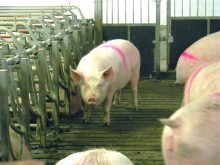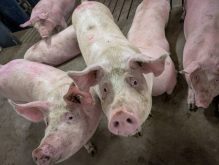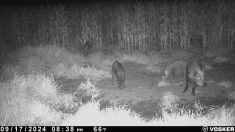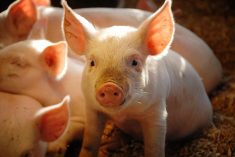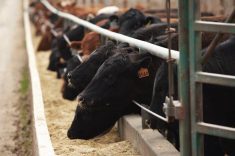The time for thinking about enrichment as “toys for pigs” has long passed.
Speaking to producers and members of the pork industry at the Manitoba Swine Seminar in Winnipeg, Jennifer Brown said not only is enrichment mandatory under the current code of practice, it actually provides benefits to both animals and those who handle them.

“Of course the other important thing, is that enrichment doesn’t have to be expensive,” said the Prairie Swine Centre researcher. “There are many practical options.”
Brown said the economic benefits of enrichment are most evident with grow-finisher pigs, where providing enrichment can significantly reduce tail biting and other forms of aggression. In grow-finisher barns, enrichment results in less injuries, less culling and fewer deaths overall.
However, producers must remember that finisher pigs are also more powerful and more destructive when it comes to enrichment and require robust items that can take prolonged and intense chewing sessions.
“Sections of chain, wood mounted in a holder or on a chain, and short sections of PVC pipe have been used successfully,” said Brown, adding that pigs at this stage prefer items like wood that they can eventually destroy.
Read Also

Pig transport stress costs pork sector
Popular livestock trailer designs also increase pig stress during transportation, hitting at meat quality, animal welfare and farm profit, Agriculture and Agri-Food Canada researcher says
Not as much research has been done on enrichment for sows being housed in stalls, she said, but group-housed sows can be treated similarly to finisher pigs.
Even how a barn is designed can result in enrichment, said Brown. Providing “bedroom areas and hallways” is one way to introduce stimulation, as is providing varied types of flooring. Small amounts of straw can be introduced too, enough for animals to explore and root through, although fully slatted systems may be challenging to adapt.
“Anything that changes up the visual, the auditory environment, is enrichment as well,” Brown added. “You’re presenting the animals with a varied soundscape so that when they are in movement or in transport this is not a shock to them.”
Changing up feed can also provide animals with enrichment. Sows in particular benefit from being given hay and high-fibre foods, which Brown explained can reduce aggression by increasing satiety.
Piglets can benefit from a variety of rubber toys, including dog toys, which can be easily cleaned. Handlers should note however, that novelty does wear off and that enrichment items should be rotated with a rest period of about five days before they are reintroduced.
Brown said that research has even shown that pigs given enrichment from birth are more intelligent than animals that don’t have enrichment, making it easier for them to adapt to change and overcome fear.
“That’s especially important if you are planning to develop gilts for an electronic feeding system,” she added. “It also increases an animal’s ability to cope with behavioural and physiological changes, stress at transport, changing pens, moving sows around… so you can definitely see why you would want to implement these sorts of things.”







